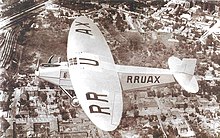Konstantin Alexejewitsch Kalinin
Konstantin Kalinin ( Russian Константин Алексеевич Калинин ; Ukrainian Калінін Костянтин Олексійович born December 17, jul. / 29. December 1889 greg. In Warsaw ; † 22. October 1938 in Voronezh ) was a Soviet aircraft designer .
Life
Kalinin was the son of an officer, his mother was Polish. He joined the army in 1912 after completing the course at the military school in Odessa. In 1916 he was trained at the military aviation school in Gatchina and then transferred to the southern front in Romania as a pilot . In 1918 he served in the aviation of the Ukrainian People's Republic . During the civil war , he converted to the Bolsheviks in 1920 . But since he was considered unreliable, he was not allowed to pursue his career as an aviator, but was assigned to the ground crew. He was also released from the Moscow Red Air Fleet Engineering Institute.
Kalinin went to Kiev, where he was admitted to the Polytechnic Institute in 1923. At the end of 1925 he received his engineering degree. Since it was clear to him that he would not be allowed to work as a pilot again, he turned to aircraft construction. He started work in the aircraft repair plant "Remwosduchsawod-6" (RWS-6) as head of the design office. The “ An ” aircraft of the design office founded by Oleg Antonov are still being built in this plant .
Kalinin developed a number of civil aircraft, starting with the Kalinin K-1 , which formed the backbone of the Dobrolet's air fleet . These civilian models were all single-engine high- wing aircraft, had a tubular frame covered with canvas and mostly a wooden wing structure. A special feature of Kalinin's designs was the elliptical airfoil floor plan, as was later also used in the Supermarine Spitfire or the Heinkel He 111 . The giant Kalinin K-7 aircraft for up to 128 passengers caused a stir in 1933 . The most famous military type is the flying wing - Kalinin K-12 , which was ready for series production in 1937 and was demonstrated in Tushino .
A total of 16 different patterns including their modifications were designed in Kalinin's design department.
Kalinin also experimented with new aircraft shapes, particularly a tailless delta wing model . The calculated properties of the Kalinin K-15 were promising. The designs were created parallel to the work of the German Alexander Lippisch . The findings of Kalinin finally flowed into the construction of fighter planes that were equipped with delta wings in the 1950s.
Kalinin fell victim to the Great Terror under Stalin . He was arrested on March 31, 1938, and sentenced to death on October 22, 1938 in a ten-minute trial before the Military College of the Supreme Court of the USSR without defense counsel or witnesses for alleged anti-Soviet activities and espionage. The sentence was carried out immediately. Kalinin's family received notice that he had been sentenced to 10 years in a labor camp with no right to correspondence. She was later notified that he had died on April 27, 1940. This date has since been given as the time of Kalinin's death in some Soviet publications. Many years after Stalin's death, he was legally rehabilitated from all charges.
On November 2, 1990, an asteroid was named after Kalinin: (3347) Constantine .
Constructions and projects
- Kalinin K-1
- Kalinin K-2
- Kalinin K-3
- Kalinin K-4
- Kalinin K-5
- Kalinin K-6
- Kalinin K-7
- Kalinin K-9
- Kalinin K-10
- Kalinin K-12
- Kalinin K-13
- Kalinin K-15
literature
- Article Kalinin Konstantin Alexejewitsch in the Great Soviet Encyclopedia (BSE) , 3rd edition 1969–1978 (Russian)
Web links
Individual evidence
- ↑ Wilfried Copenhagen : Encyclopedia Soviet aviation. Transpress, Berlin 1986, ISBN 3-344-00005-5 , p. 113.
- ^ I. Borislawov: The aircraft designer in the shadow - Konstantin Kalinin , Klub Krile, H. 12/1996 (Bulg.)
- ↑ DA Sobolev: The reprisals in the Soviet aircraft industry , VIET, 2000 (Russ.)
| personal data | |
|---|---|
| SURNAME | Kalinin, Konstantin Alexejewitsch |
| ALTERNATIVE NAMES | Калинин, Константин Алексеевич (Russian spelling) |
| BRIEF DESCRIPTION | Soviet aircraft designer |
| DATE OF BIRTH | December 29, 1889 |
| PLACE OF BIRTH | Warsaw |
| DATE OF DEATH | October 22, 1938 |
| Place of death | Voronezh |

